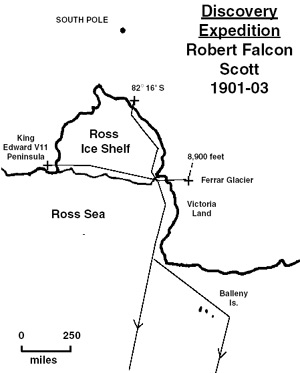
| Glasgow Digital Library | Voyage of the Scotia | BRUCE | PEOPLE | SHIP | ANTARCTIC | INDEX |
|---|

The Discovery expedition was the first extensive exploration of the landward part of the Antarctic continent. Sledges, dogs and men set off to explore the interior. There were 19 dogs at the outset and the men also helped to pull the sledges. At 79°S the support party returned and Robert Scott, Ernest Shackleton and Dr Wilson continued south. The dogs were not doing well and their diet of fish meal did not agree with them.
On 8 December 1902 Scott reported: 'Wilson can always tell of a storm coming as he suffers from rheumatism'. Wilson later reported that Shackleton's gums were very red - the first sign of scurvy. The suspected cause was the bacon, but it was realised that they had not taken enough food. On 26/27 December Wilson had a bad attack of snow blindness. On 31 December, at 82°16'S, they decided turn back. Wilson and Scott were both showing signs of scurvy and Scott was liable to attacks of coughing. Shackleton could no longer help with the pulling of the sledge and continued on skis. Scott said:
'In spite of our disbelief in ski, one is bound to confess that if we get back safely, Shackleton will owe much to the pair he is now using.'
On 25 January 1903 they saw the smoke of Mount Erebus. On 28 January they reached a food depot.
They had survived for three weeks on two weeks' supply of food. All the dogs had died during the journey. On 4 February they returned to Discovery after covering 1,550km (960 miles) in a 93-day trek. The South Pole was never really an option on this trip due to the equipment, food supply and poor performance by the dogs. They had walked halfway to the pole and the knowledge gained would help in the Terra Nova expedition of 1910.
On their return, the relief ship Morning had arrived with supplies and mail. Scott had left messages at several prominent headlands in the south so that any relief ship could find them in McMurdo Sound. The crew were all pleased to receive the first news for a year. Several of the crew returned with the Morning - five were Merchant Navy men (including Ernest Shackleton), two were civilians and one was Royal Navy.
Morning sailed on 3 March 1903. Discovery was expected to be trapped in the ice for another winter.
During the winter and the long hours of darkness many activities took place in and around the camp, from scientific observation to the crew's own entertainments. In the spring (September), several sledging expeditions took place. The main journeys were along the ice barrier to the east and the western journey up the Ferrar Glacier. Temperatures had been low and when the reconnaissance party returned there had been a temperature of -55°C on the barrier (their thermometer had then broken).

| Glasgow Digital Library | Voyage of the Scotia | BRUCE | PEOPLE | SHIP | ANTARCTIC | INDEX |
|---|